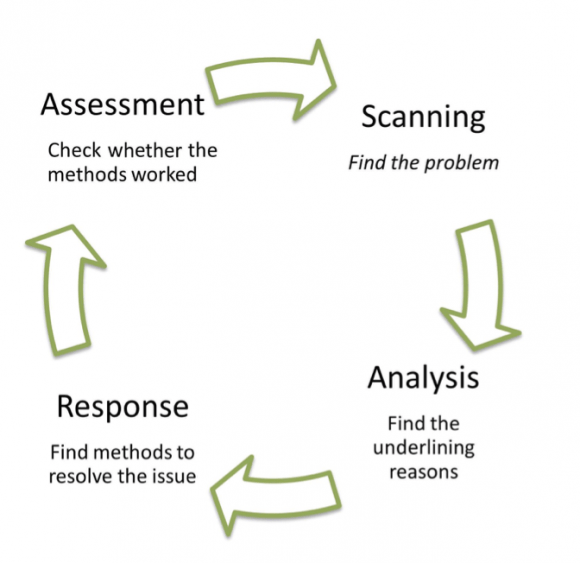Uncategorized | March 11th, 2020
A look inside strategies contributing towards Community Policing: SARA Model

Problem-Oriented Policing (POP) is a defined process for responding to reported (or perceived) issues. This model requires that officers be familiar with their areas/communities and be willing and able to develop personal relationships. In POP, officers are encouraged to use the SARA problem-solving model to solve issues in their communities.
A commonly used problem-solving method is the SARA model (Scanning, Analysis, Response and Assessment). The SARA model contains the following elements:
Scanning:
This first
step requires police to recognize recurring issues and their respective
outcomes within their communities.
Police forces must then prioritize these issues and develop
goals to resolve the issue at hand. Officers must then further examine problems
within the larger issue.
- Identifying recurring problems of concern to the public and the police.
- Identifying the consequences of the problem for the community and the police.
- Prioritizing those problems.
- Developing broad goals.
- Confirming that the problems exist.
- Determining how frequently the problem occurs and how long it has been taking place.
- Selecting problems for closer examination.
Analysis:
To analyze a
problem, police need to identify and understand the causes and entailments of
an issue as well as collect data on the problem.
Through research, the analysis step makes officers specify
current responses to an issue, the scope of an issue, resources, and potential
reasons for the issue’s occurrence.
- Identifying and understanding the events and conditions that precede and accompany the problem.
- Identifying relevant data to be collected.
- Researching what is known about the problem type.
- Taking inventory of how the problem is currently addressed and the strengths and limitations of the current response.
- Narrowing the scope of the problem as specifically as possible.
- Identifying a variety of resources that may be of assistance in developing a deeper understanding of the problem.
- Developing a working hypothesis about why the problem is occurring.
Response:
The response step enables police to use their research from the analysis step to brainstorm ideas for intervention, select intervention options, outline plans and objectives, and implement proposed plans.
- Brainstorming for new interventions.
- Searching for what other communities with similar problems have done.
- Choosing among the alternative interventions.
- Outlining a response plan and identifying responsible parties.
- Stating the specific objectives for the response plan.
- Carrying out the planned activities.
Assessment:
The final step
of the SARA model takes place after forces have tried to solve a problem.
Assessment requires police to evaluate the success of their
implemented plan and collect data regarding its outcomes. During this step,
police forces also determine whether their initial goals were met and try to
better ensure continued success.
- Determining whether the plan was implemented (a process evaluation).
- Collecting pre– and post–response qualitative and quantitative data.
- Determining whether broad goals and specific objectives were attained.
- Identifying any new strategies needed to augment the original plan.
- Conducting ongoing assessment to ensure continued effectiveness.
Baum, Erica. “Police Work: What Is the SARA Model?” Newsmax, June 3, 2015, January 10, 2020.
Hawk, Christopher. “What is the difference between community policing, community-oriented policing and problem solving?” Quora, January 20, 2014.
Editorial Disclaimer: All blog posts are contributed by a member of the MovementForward, Inc. team in their personal capacity. The opinions expressed in the posts are the author’s own and do not reflect the views of MovementForward, Inc. or any other partnership associated with the organization.
